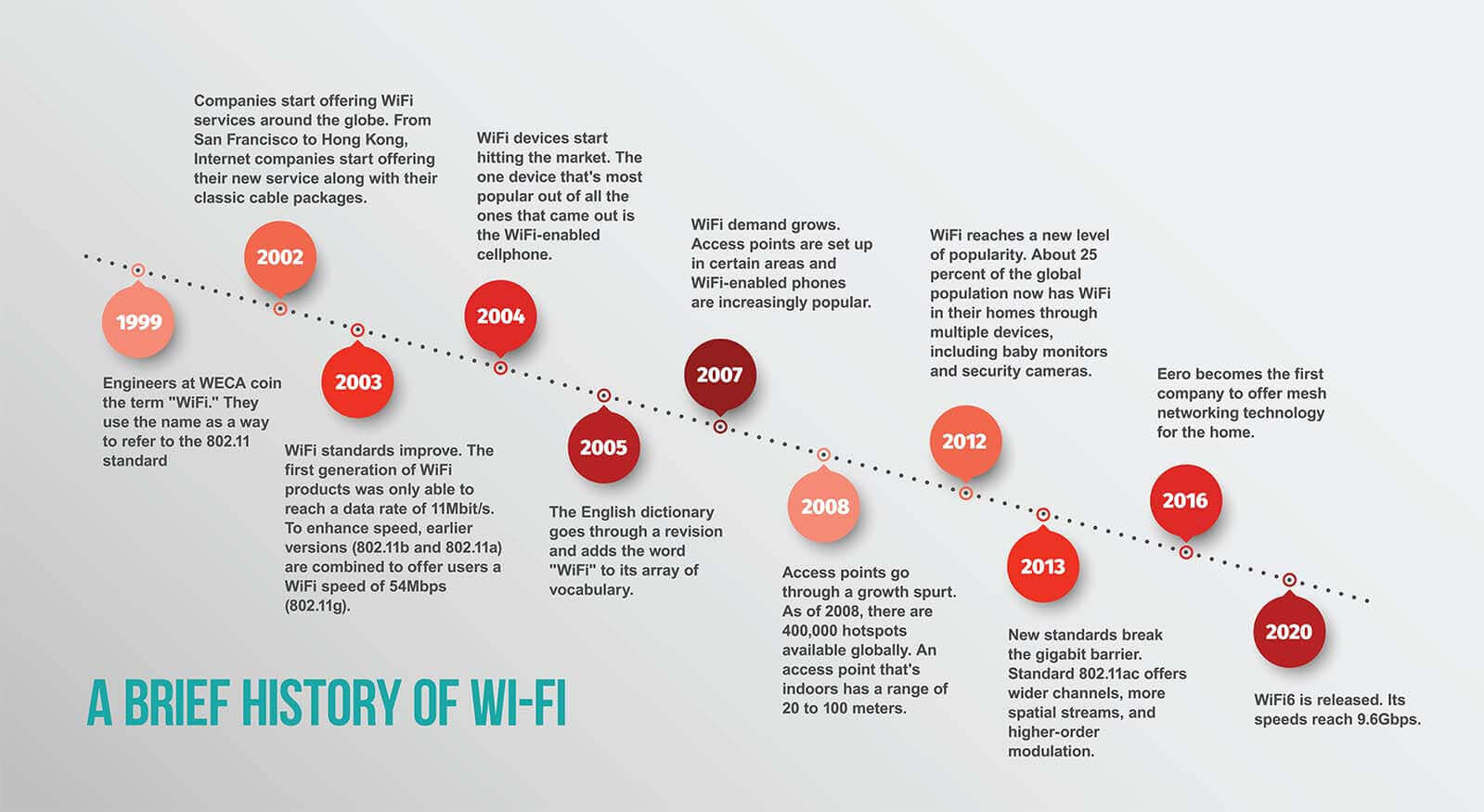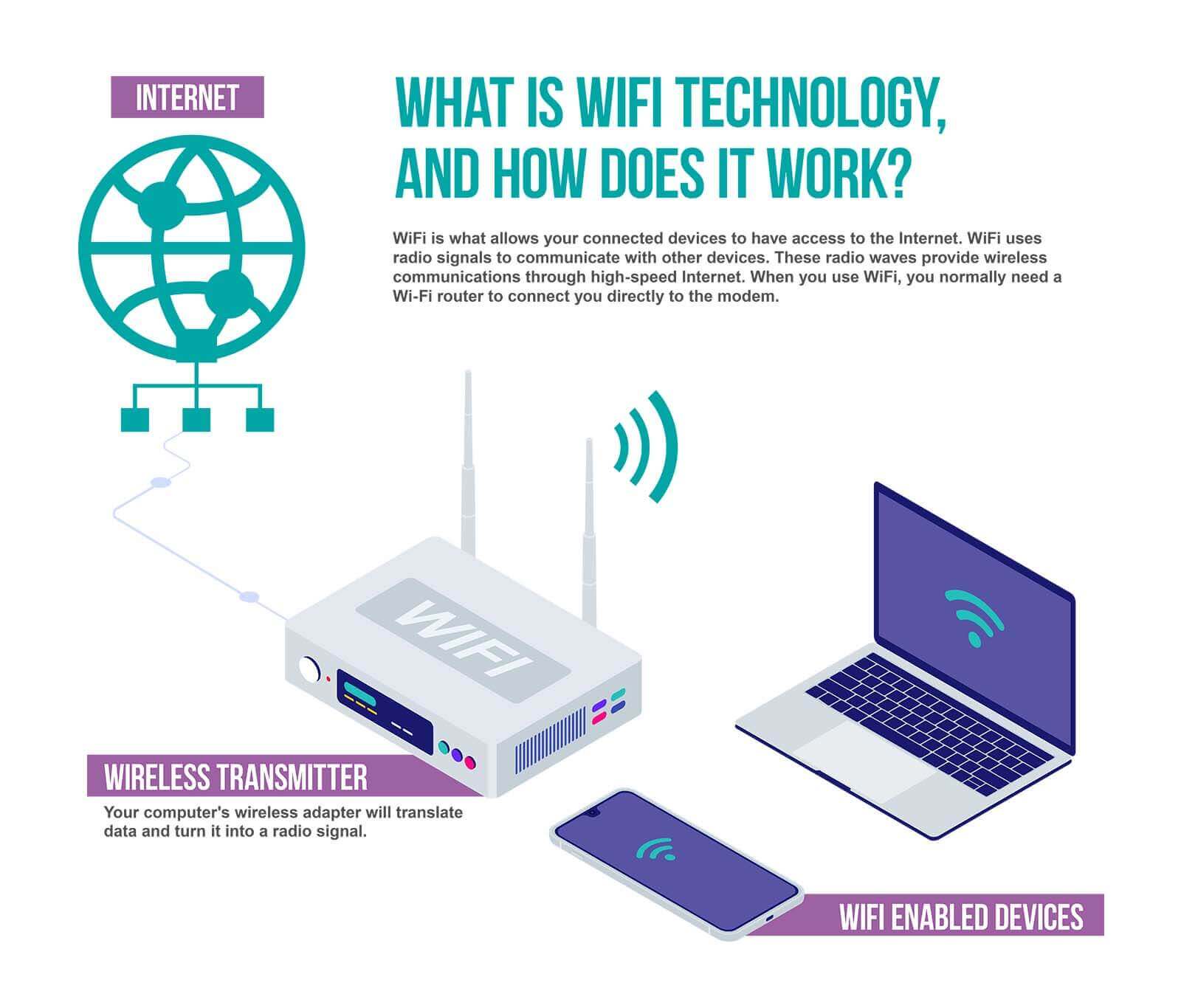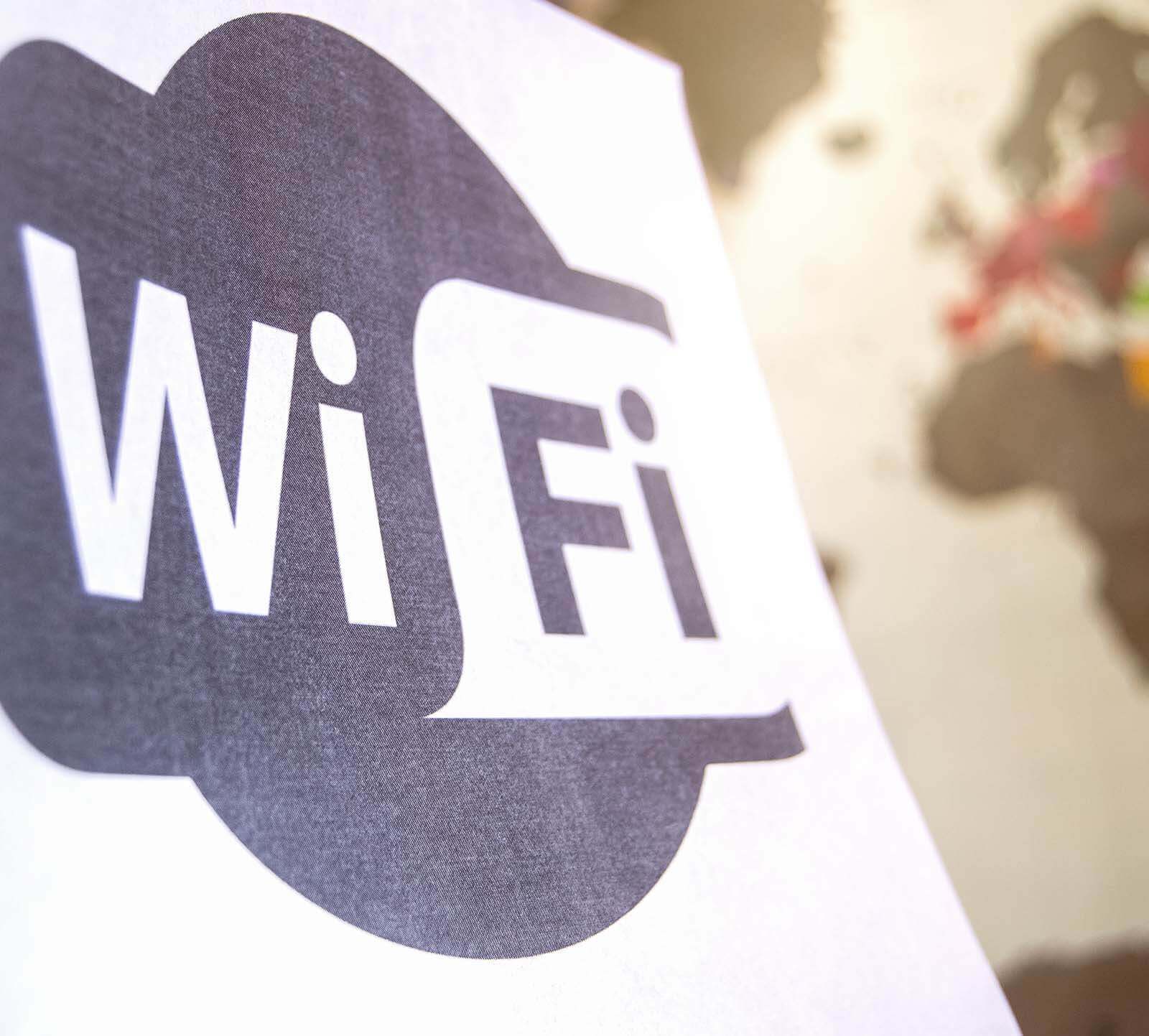Table of Contents
Are you happy with your Internet service?

About the author
James Murray
Watch our provider review videos
Video ReviewsWhich speed do I need?
Tell us what you use Internet for
How many users?
A Brief History of WiFi
These days, it’s uncommon to own a device that doesn’t have Wi-Fi access. Forecasts suggest that by 2030, there will be around 50 billion connected devices around the world. It’s hard to think of a time when wireless networks weren’t everywhere.
Still, wireless communications have only been around since the 1970s. And even though Wi-Fi technology has made a lot of impressive advancements, it’s still only the beginning.
With the introduction of distance coverage, being connected in public spaces has become more accessible than before. From San Francisco to New York, and everywhere else around the world, there’s no limit to your wireless connectivity.
So, how did wireless Internet become what it is today? What started with a simple home radio turned into a wireless technology that now uses the same electromagnetic waves Heinrich Rudolf Hertz documented back in the 1880s.
A lot has changed since the commercialization of Wi-Fi networks. Here’s everything you need to know about the history of WiFi.
Who Invented Wi-Fi Technology?
When wireless technology first started, there were no devices that could automatically connect to a network. Electricity was still a new concept.
Back in the 1880s, the idea of wireless technology was swirling around in the brain of Heinrich Rudolph Hertz. In the Industrial Age, the radio was the first invention to establish wireless communications.
Hertz was the first person to discover radio waves and document their transmission. He did this as part of the development of a communication system. His work with radio waves would eventually lead to his name becoming a unit for measuring frequencies.
However, even though Hertz was the originator of one aspect of Wi-Fi technology, he’s not the only one who contributed to the history of Wi-Fi. Here are some other organizations and individuals who advanced to wireless internet technologies.

John O’Sullivan
Dr. John O’Sullivan is the engineer responsible for coming up with wireless LANs. A wireless LAN is a computer network that links multiple devices using wireless technologies.
The invention of a wireless LAN helped make Wi-Fi signals reliable and faster. This technology was key in the development of Wi-Fi communications. It helped solidify the development of wireless local area networks and increase the number of connected devices consumers could use.
Born in Australia, O’Sullivan and his team of engineers made their revolutionary invention in 1977 while working in the Netherlands’ Dwingeloo Radio Observatory. O’Sullivan has been widely recognized for his contribution to Wi-Fi communications. In 2017, he was awarded the Masaru Ibuka Consumer Electronics Award from the Institute of Electrical and Electronics Engineers (IEEE).

Hedy Lamarr
One of the most interesting facts about the history of Wi-Fi is its connection to the Australian movie star Hedy Lamarr. She was well known in the 1940s for films like Algiers and Sampson and Delilah, but her most valuable contribution to history was the frequency-hopping technology that preceded GPS and Bluetooth devices commonly used today.
During the Second World War, Lamarr would often toy with radio signals to aid during the war effort. One evening, Lamarr and George Antheil accidentally discovered a technique called “frequency hopping."
This seemingly small invention was responsible for allowing allied torpedoes to strike their targets without being affected by radio jamming. Frequency hopping was an important tool during the war as it contributed greatly to Allied success.
More than that, the new technology became the foundation for today’s Wi-Fi and wireless products. If it wasn’t for frequency hopping, we wouldn’t enjoy Wi-Fi in public spaces like coffee shops and office buildings.

Vic Hayes
Often referred to as “The Father of Wi-Fi," Vic Hayes was the chair of the committee that created the IEEE 802.11 standards. He famously established standards for Wi-Fi before it was even available to the public.
It’s because of Vic Hayes that the 802.11 sets of standards were created. These are standards that are still in place today and that make Wi-Fi technology usable for everyone.
Improvements to the wireless networking standard continue to be made and continue to play an important role for consumers everywhere.
The Institute of Electrical and Electronics Engineers (IEEE)
Formed in 1963, this New York-based organization is responsible for bringing together technical professionals from around the globe, including John O’Sullivan. They’re famous for setting up industry standards for companies to comply with WiFi regulations.
The main standard that the IEEE is known for is the IEEE 802.11 which is compatible with all WiFi products. This is something that the Wi-Fi alliance helps with, as they are in charge of testing products to make sure that the standard IEEE 802.11 is complied with by different organizations.
The Wi-Fi Alliance
The Austin-based trade association focuses on the certification of Wi-Fi gadgets and technology. The Wi-Fi alliance is mostly known for owning the Wi-Fi logo that must appear on all products conforming to the IEEE 802.11 standard.
The organization started in 1999 as the Wireless Ethernet Compatibility Alliance (WECA). This was after wireless internet companies found a gap in the way technological devices adhered to standards like IEEE 802.11.
When was Wi-Fi First Invented?
Although modern Wi-Fi has its roots in the 1880s, wireless local area networks were not formally established until 1971. It was during this year that ALOHAnet used Ultra High Frequency (UHF) radio waves to connect the island of Hawaii with the first version of wireless internet.
The initial Wi-Fi-connected seven computers across different Hawaiian islands. The seven computers were able to communicate with a central computer all without using phone lines. This was a huge deal at the time, as it had never been done before.

What Is the History of WiFi?
Since its conception in 1971, there has been an increasing need for Wi-Fi connections that can support all the devices you use today. The implementation of IEEE 802.11 standards created a technology platform that allows high-speed data transfer over short distances.
By 1985, after many advancements had been made to create a wireless access point, the Federal Communications Commission approved the unlicensed use of the ISM band of the wireless spectrum. The bands of the radio spectrum were frequencies in the 2.4 GHz band. These are commonly used for low-power and short-range telecommunications like Wi-Fi, Bluetooth devices, and wireless phones.
The approval of the unlicensed ISM band by the Federal Communications Commission sped everything up. And in 1991, further progress advanced the history of WiFi.
During this time, the NCR Corporation, along with AT&T Corporation, came up with the predecessor to 802.11. This set of standards was specifically created for the use of cashier systems.
Shortly after, the first generation of Wi-Fi products came out on the market under the name of WaveLAN. They are officially credited with the invention of Wi-Fi. And they were the first company to commercialize the use of Wi-Fi.
This is where Dr. John O’Sullivan came in. He developed one of the key patents used in Wi-Fi. The creation of the patent formed part of a research project for the Commonwealth Scientific Industrial Research Organisation (CSIRO).
The project for CSIRO ended up failing, but it gave the engineers enough information about Wi-Fi systems to later develop another patent. The role of the second patent was to “un-smear" the Wi-Fi signal and provide a higher capacity for data transfer.
In 1997, after many attempts at developing a Wi-Fi technology that could work efficiently, the first version of the 802.11 protocol was released. This initial standard provided 2Mbit/s link speeds.
While the first speeds were good, the engineers were able to release an upgraded version of 802.11 in 1999 that provided a maximum data rate of 11Mbit/s able to operate in the 2.4 GHz band. This was much more popular across multiple networks.

What Is WiFi Technology?
Wi-Fi is short for “Wireless Fidelity." In simple terms, Wi-Fi is what allows your connected devices to have access to the Internet. More than that, it’s a technology that has advanced communication and enhanced computer networking.
Wi-Fi uses radio signals to communicate with other devices. Although it’s easy to confuse them, the radio signals that Wi-Fi uses are not the same ones that car radios or walkie-talkies use. Instead, they’re the same radio waves microwave ovens use to heat your food.
These radio waves provide wireless communications through high-speed internet. Think of it as a way to share an Internet connection across multiple devices in public spaces, office buildings, and airports.
When you use Wi-Fi, you normally need a Wi-Fi router to connect you directly to the modem. Once you’re plugged into the modem, the device itself will act as a hub to broadcast the signal to all the devices that are compatible with Wi-Fi. This is what makes this technology flexible and popular among Internet users.
How Does it Work?
Your computer’s wireless adapter will translate data and turn it into a radio signal. This is easily accomplished with the use of an antenna. Although the higher the Wi-Fi standard is, the more likely it is to allow devices to have multiple antennas.
Once the signal is transmitted through an antenna, your router will decode the signal after it receives it. This is what makes Wi-Fi attractive because instead of using cables to maintain a connection, it uses airwaves to communicate.
Depending on which version of Wi-Fi you have, you may encounter interference with other devices. The newer versions of Wi-Fi provide you with a much better average throughput and less interference with other household devices.
If your device can support multiple antennas, it will exploit multipath propagation characteristics on the same frequency bands and give you much faster speeds and a greater signal range.
What Is the Difference Between Wi-Fi and the Internet?
Before Wi-Fi, you could only get online through wired networks. Although it was convenient, it wasn’t practical. The main difference between Wi-Fi and the Internet is that Wi-Fi lets you access the Internet without needing cables.
The technology uses airwaves to communicate between routers without a physical connection. You can even use simultaneous dual-band routers to expand radio bands and increase the data rate speed.
Think of Wi-Fi as being the outlet through which you can access the internet without the cables. The internet is more of a vast network that links computers around the world.
What Is the Difference Between Bluetooth and Wi-Fi?
Wi-Fi is a wireless technology that your device uses to connect you to the internet without the need for a cable. Under the IEEE WiFi standards, the different frequency bands that Wi-Fi uses are split into separate channels that overlap in frequency. This is why Wi-Fi uses channels that are far apart.
Bluetooth, on the other hand, is a technology whose purpose is to transfer data over short distances between devices. Bluetooth uses radio signals just like Wi-Fi.
Bluetooth often uses the same frequency band as your Wi-Fi connection. This can cause interference problems within your home Wi-Fi network at times.
Other differences include:
- Bluetooth requires a wireless adapter to connect to devices. Whereas Wi-Fi requires a wireless adaptor and wireless router to be able to connect.
- Bluetooth consumes a lower amount of power. Wi-Fi consumes high power.
- Because Bluetooth doesn’t require a password to connect, it’s less secure than Wi-Fi. On the other hand, Wi-Fi is a much more secure network to use on your device.
- Bluetooth has a radio signal range of ten meters. Whereas Wi-Fi has a radio signal range of one hundred meters.
- Bluetooth requires low bandwidth. Whereas Wi-Fi requires higher available bandwidth.
Wi-Fi Frequencies for Wireless Local Area Networks
Wi-Fi runs on two main frequencies: 2.4 GHz and 5 GHz. Up until recently, many users preferred 2.4 GHz over 5GHz because it was compatible with most devices and a lot less expensive than 5 GHz.
However, in 2003, as Wi-Fi technology started to advance, the 802.11g standard was born. This particular standard was a combination of the two previous ones, which made it faster and able to cover longer distances.
The Arrival of 802.11n
By 2009, the final version of 802.11n was released to the public. This particular standard was much faster and reliable than the ones before due to its use of multiple antennas to enhance communication. In turn, this allowed for an increase in data without users needing a higher bandwidth.
Overcrowding with Connected Devices
Although 2.4 GHz was always more popular than 5 GHz, there was a time in which consumers preferred the latter. The reason is that because of the extended range that the 2.4 GHz frequency offered, it tended to clash with other appliances and devices, like microwave ovens.
Consequently, people started using the 5 GHz to prevent overcrowding and interference. This was a big push towards the use of dual-band routers.
Simultaneous Dual-Band Routers
The main idea behind dual-band routers was to solve the issue of overcrowding. Nobody wants to experience a slow Wi-Fi connection. And this was something that dual-band routers aimed to fix.
With the addition of the device on the market, you could now have a router that supported both 24 GHz and 5 GHz. It was able to do this because it was built with two types of wireless radios that could support both connections at the same time.
The way it worked was by connecting devices to the faster frequency within the range. If the device was too far away from the router, then it automatically connects you to the 2.4 GHz frequency as a backup.
The Addition of Wi-Fi 6
In the year 2020, Wi-Fi 6 was released into the market. This new technology promoted faster connectivity and speeds of up to 9.6 Gbps.
The jump in capabilities is because WiFi 6 can mitigate issues between the connected devices and overcrowding. Wi-Fi 6 routers can connect to more devices at one time without hiccups. They can also send data to multiple devices in the same broadcast.
When Did Wi-Fi Become Popular?
Home Wi-Fi became available for everyone in 1999. However, it wasn’t until the mid-2000s that Wi-Fi became a commercial hit across the globe. This was the time when the term itself was added to the dictionary, Wi-Fi-enabled phones came out on the market, and Wi-Fi device sales go through the roof.
A Brief History of Wi-Fi: 1971 to Today
A lot of significant changes form part of the Wi-Fi history. What was once a new technology is now a standard of connectivity. Although earlier Wi-Fi technologies started with lower frequencies, they are now a thing of the past. Thanks to the FCC’s approval of the unlicensed use of ISM bands, today’s Wi-Fi surpasses the days of its conception.
1999 Engineers at WECA coin the term “Wi-Fi." They use the name as a way to refer to the 802.11 standards.
2002 Companies start offering Wi-Fi services around the globe. From San Francisco to Hong Kong, Internet companies start offering their new service along with their classic cable packages.
2003 Wi-Fi standards improve. The first generation of Wi-Fi products was only able to reach a data rate of 11Mbit/s. To enhance speed, earlier versions (802.11b and 802.11a) are combined to offer users a Wi-Fi speed of 54Mbps (802.11g).
2004 Wi-Fi devices start hitting the market. The one device that’s most popular out of all the ones that came out is the Wi-Fi-enabled cellphone.
2005 The English dictionary goes through a revision and adds the word “Wi-Fi" to its array of vocabulary.
2007 Wi-Fi demand grows. Access points are set up in certain areas and Wi-Fi-enabled phones are increasingly popular.
2008 Access points go through a growth spurt. As of 2008, there are 400,000 hotspots available globally. An access point that’s indoors has a range of 20 to 100 meters.
2012 Wi-Fi reaches a new level of popularity. About 25 percent of the global population now has Wi-Fi in their homes through multiple devices, including baby monitors and security cameras.
2013 New standards break the gigabit barrier. Standard 802.11ac offers wider channels, more spatial streams, and higher-order modulation.
2016 Eero becomes the first company to offer mesh networking technology for the home.
2020 Wi-Fi 6 is released. Its speeds reach 9.6Gbps.

The Wi-Fi Brand and Trademark
In 1999, the Wi-Fi Alliance was formed as a trade association so that it could own the Wi-Fi trademark that is required for products to be under. The term “Wi-Fi" doesn’t mean anything. But the brand-consulting firm advising the Wi-Fi Alliance wanted to find a better name for the technology than “IEEE 802.11b Direct Sequence."
Founding member of the Wi-Fi Alliance, Phil Belanger has been known to say that the consulting firm invented the term “Wi-Fi" as a pun on the word “Hi-Fi." The ying-yang coloring of the original logo indicates the certification of a product for interoperability.

Wi-Fi Today and The Internet of Things
In the year 2022, there are approximately 549 million public hotspot sites around the world. This trend towards access point growth is expected to continue well into the next decade. Nowadays, Wi-Fi access points are set up at home, in schools, and throughout most places you frequent.
The Internet of Things (IoT) is just one of the many advantages that have come with the invention of Wi-Fi. IoT refers to a network of physical objects that use Wi-Fi to connect and exchange data over the internet. IoT includes all the devices that support a smart home.
Very much like the IoT, Wi-Fi can improve efficiency and bring vital information to the surface more quickly than humans. As the technology advances, there’s no end to what Wi-Fi can accomplish.

About the author
